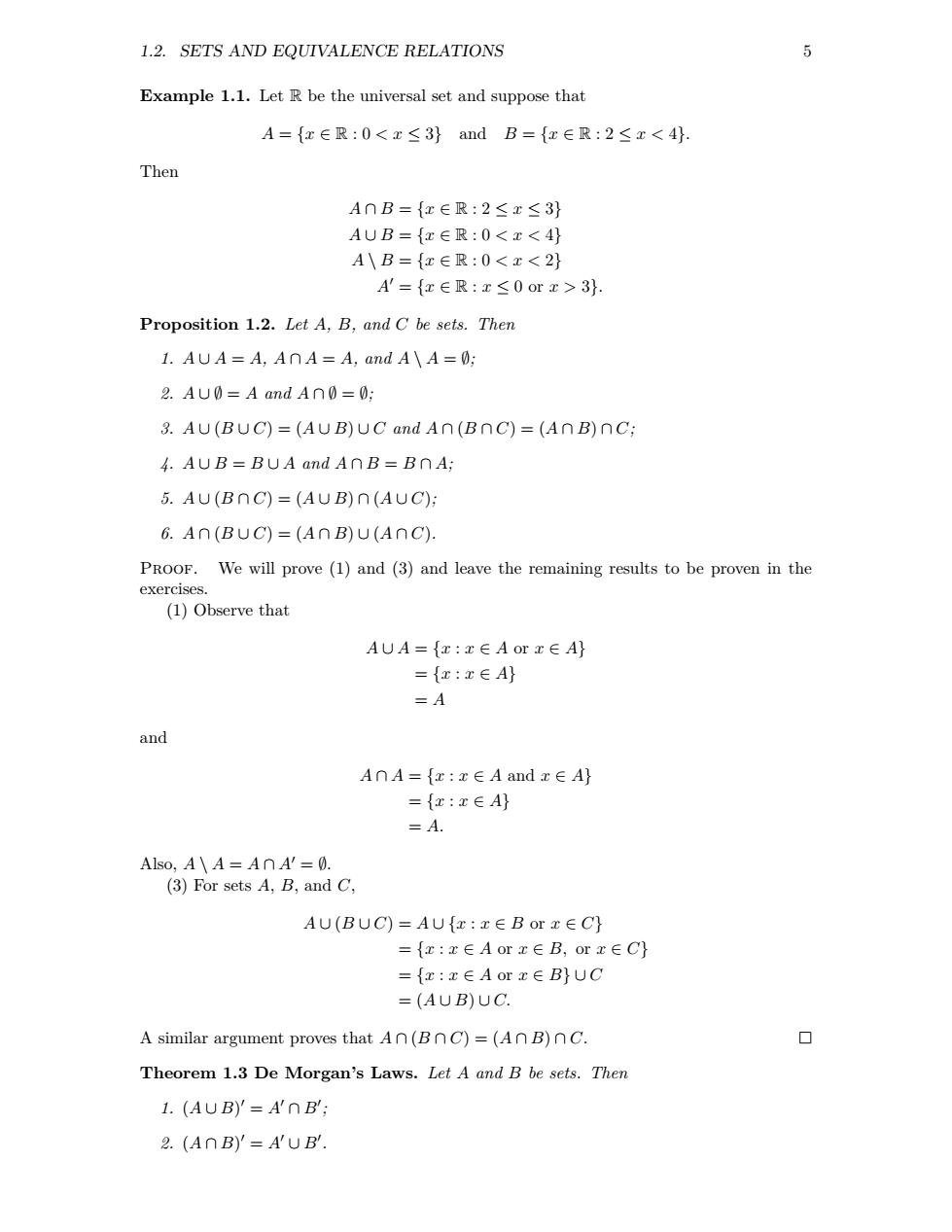正在加载图片...

1.2.SETS AND EQUIVALENCE RELATIONS 5 Example 1.1.Let R be the universal set and suppose that A={x∈R:0<x≤3}andB={x∈R:2≤x<4}. Then AnB={x∈R:2≤x≤3} AUB={x∈R:0<x<4} A\B={x∈R:0<x<2} A'={x∈R:x≤0orx>3}. Proposition 1.2.Let A,B,and C be sets.Then 1.AUA=A,AnA=A,and A\A=0; 2.AU0=A and An0=0; 3.AU(BUC)=(AUB)UC and An(BnC)=(AnB)nC; 4.AUB=BUA and AnB=BnA; 5.AU(B∩C)=(AUB)∩(AUC): 6.A∩(BUC)=(A∩B)U(A∩C) PROOF.We will prove (1)and (3)and leave the remaining results to be proven in the exercises. (1)Observe that AUA={x:x∈Aorx∈A} ={x:x∈A} =A and AnA={x:x∈A and x∈A} ={x:x∈A} =A. Also,A\A=AnA'=0. (3)For sets A,B,and C, AU(BUC)=AU{x:x∈Borx∈C} ={x:x∈Aorx∈B,orx∈C} ={x:x∈Aorx∈B}UC =(AUB)UC. A similar argument proves that An(BnC)=(A0 B)nC. O Theorem 1.3 De Morgan's Laws.Let A and B be sets.Then 1.(AUB)'=A'∩B; 2.(A∩B)'=A'UB.1.2. SETS AND EQUIVALENCE RELATIONS 5 Example 1.1. Let R be the universal set and suppose that A = {x ∈ R : 0 < x ≤ 3} and B = {x ∈ R : 2 ≤ x < 4}. Then A ∩ B = {x ∈ R : 2 ≤ x ≤ 3} A ∪ B = {x ∈ R : 0 < x < 4} A \ B = {x ∈ R : 0 < x < 2} A ′ = {x ∈ R : x ≤ 0 or x > 3}. Proposition 1.2. Let A, B, and C be sets. Then 1. A ∪ A = A, A ∩ A = A, and A \ A = ∅; 2. A ∪ ∅ = A and A ∩ ∅ = ∅; 3. A ∪ (B ∪ C) = (A ∪ B) ∪ C and A ∩ (B ∩ C) = (A ∩ B) ∩ C; 4. A ∪ B = B ∪ A and A ∩ B = B ∩ A; 5. A ∪ (B ∩ C) = (A ∪ B) ∩ (A ∪ C); 6. A ∩ (B ∪ C) = (A ∩ B) ∪ (A ∩ C). Proof. We will prove (1) and (3) and leave the remaining results to be proven in the exercises. (1) Observe that A ∪ A = {x : x ∈ A or x ∈ A} = {x : x ∈ A} = A and A ∩ A = {x : x ∈ A and x ∈ A} = {x : x ∈ A} = A. Also, A \ A = A ∩ A′ = ∅. (3) For sets A, B, and C, A ∪ (B ∪ C) = A ∪ {x : x ∈ B or x ∈ C} = {x : x ∈ A or x ∈ B, or x ∈ C} = {x : x ∈ A or x ∈ B} ∪ C = (A ∪ B) ∪ C. A similar argument proves that A ∩ (B ∩ C) = (A ∩ B) ∩ C. Theorem 1.3 De Morgan’s Laws. Let A and B be sets. Then 1. (A ∪ B) ′ = A′ ∩ B′ ; 2. (A ∩ B) ′ = A′ ∪ B′